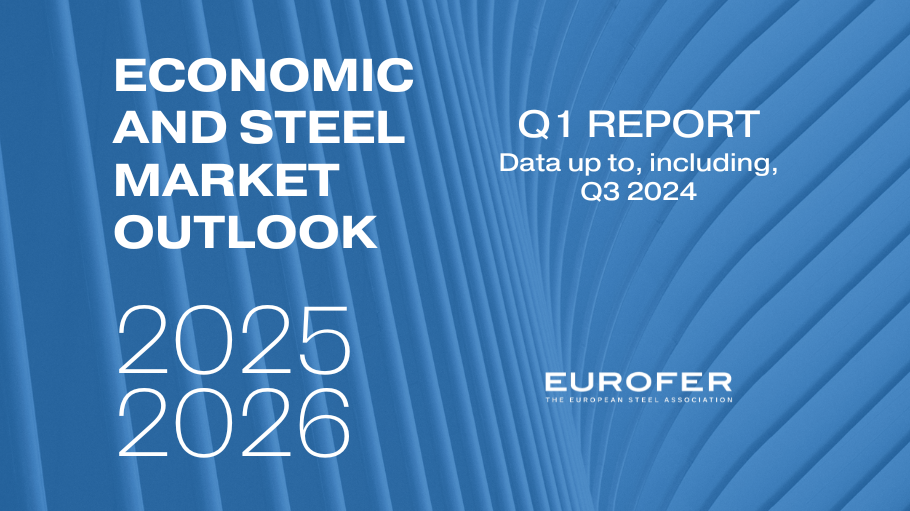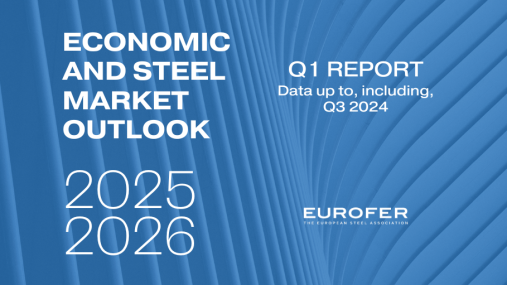
Publications » Economic and market outlook » Economic and steel market outlook 2025-2026, first quarter
Economic and steel market outlook 2025-2026, first quarter
Downloads and links
Recent updates

The negative trend in the steel market which began in the second half of 2022 has continued up to the third quarter of 2024. The current downturn in EU apparent steel consumption, reflecting poor demand conditions, began in the second quarter of 2022, due to war-related disruptions, along with unprecedented rises in energy prices and production costs. Demand conditions have been worsening considerably since the second half of 2022, and this negative cycle has continued until the third quarter of 2024, mainly as a result of growing global economic uncertainty, higher interest rates – before recent policy rate cuts were implemented - and overall manufacturing weakness. The dire consequences of the conflict in Ukraine and the energy shock on steel-using industries, along with worsened overall economic outlook, triggered a severe recession (-8%) already in 2022. These protracted downside factors further impacted apparent steel consumption in 2023, resulting in another annual drop (-6%). This represented the fourth annual recession in the last five years.
In 2024, against expectations of more favourable developments in the industrial outlook and improvement in steel demand earlier this year, apparent steel consumption is set to experience another drop, more severe than previously foreseen (-2.3%, formerly -1.8%). In 2025, apparent steel consumption is projected to recover at a slower pace than our previous outlook (+2.2% vs. +3.8%), conditional on a positive evolution of the industrial outlook and easing global tensions, which are unpredictable at the moment.
The overall evolution of steel demand remains subject to very high uncertainty. No improvement in apparent steel consumption is expected before the first quarter of 2025, and consumption volumes are expected to remain far below pre-pandemic levels.
EU steel market overview
In the third quarter of 2024, apparent steel consumption continued to drop (-0.9%, after -1.4% in the preceding quarter). Total consumption volume in the third quarter of 2024 stood at 30.4 million tonnes.
Domestic deliveries mirrored the evolution in demand and contracted (-2.3%, after -1.6% in the preceding quarter). In 2022, deliveries plummeted (-9%), reflecting the sharp deterioration in demand. As a result of protracted negative trends throughout the year, domestic deliveries markedly dropped again (-4.6%) in 2023.
Imports into the EU - including semi-finished products - slightly increased (+1%) in the third quarter of 2024, after a contraction in the preceding quarter (-1.8%). It is worth noting that in absolute volumes the share of total imports out of apparent consumption has remained considerably high in historical terms throughout 2023 and up to the third quarter of 2024, rising to 28% as already seen in the second quarter.
EU steel-using sectors
In the third quarter of 2024, the Steel Weighted Industrial Production index (SWIP) sharply dropped (-4.1%) for the third consecutive time (-2.1% in the preceding quarter). Until the end of 2023, EU steel-using sectors’ output continued to show resilience and grow, albeit at a slower pace. This was despite the prolonged impact of Russia’s invasion of Ukraine, overall manufacturing weakness and global geopolitical tensions, along with above-average energy prices.
The positive trend in overall SWIP, started after the pandemic, continued up to the fourth quarter of 2023, in spite of soaring energy prices impacting production costs, component shortages and lower output that began to take their toll on total production activity in steel-using sectors in the second half of 2022. The deterioration of the economic and industrial outlook in the EU – particularly due to high inflation and the subsequent interest rate hike by the European Central Bank (ECB) – had only a limited impact on steel-using sectors’ output up to the end of 2023, with the exception of the construction sector. As the industrial and economic landscape has turned even gloomier in the EU during 2024, developments of the SWIP index were driven by a continued downturn in the construction, mechanical engineering, domestic appliances and metalware sectors, as well as in the automotive sector. The construction sector, in particular, had already entered recession in the third quarter of 2022, and this trend –except for a couple of quarters - has continued up to the third quarter of 2024. Its recessionary trend is expected to persist until the first quarter of 2025.
Ongoing economic uncertainty is set to continue taking its toll on growth also in the upcoming quarters, despite monetary easing by the European Central Bank (five consecutive 25 basis points policy rate cuts in the course of 2024 and January 2025), the effects of which will not be fully visible in the short-term.
In 2024, steel-using sectors’ output growth is projected to experience a steeper drop than previously foreseen (-3.3% revised downwards from -2.7%). This is mainly due to expected drops in construction and automotive output. A more modest recovery is anticipated in 2025 (+0.9%, also revised downwards from +1.6%), before another moderate increase in 2026 (+2.1%).
Conclusions
The ongoing economic uncertainty is set to continue affecting steel market growth from the demand side over the upcoming quarters:
1. Despite EU industry proving quite resilient throughout 2023, the outlook for the fourth quarter of 2024 and the first quarter of 2025 remains dominated by a worsening combination of uncertainties in energy prices, weak manufacturing sectors’ conditions, inflation still above target levels, severe geopolitical tensions and economic challenges, including possible future trade tensions. Despite recent monetary easing, its effects on the economic cycle will not be visible in the short-term.
2. While output grew more than expected (+2.9%) in 2022, SWIP growth in 2023 slowed down but achieved a higher-than-estimated rate (+1.6%, previously +0.9%), albeit with wide differences among individual EU economies and industrial sectors.
3. In 2024, growth in steel-using sectors is projected to decline more sharply than previously estimated (-3.3% vs. -2.7%), due to the recession in the two major steel-consuming sectors, namely construction and automotive. Persistent geopolitical tensions and the lagged impact on monetary easing weighed on the overall manufacturing sector. More moderate growth is expected in 2025 (+0,9%, revised downwards from +1.6%), with some acceleration in 2026 (+2.1%).

Download this publication or visit associated links
Developed with the support of the Offshore Wind Foundation Alliance and European Wind Tower Association, the position paper outlines the strategic importance of wind components for Europe’s green transition and calls for targeted measures to strengthen their role within the NZIA.
Brussels, 2 April 2025 - The latest data unveiled by the OECD in its meeting in Paris draw an extremely worrying picture, where global steel excess capacity is expected to grow from an estimated 602 million tonnes in 2024 to 721 million tonnes by 2027 – over five times the EU's steel production. The European steel industry - already severely hit by the spill-over effects of global overcapacity and the U.S. steel import tariffs - reiterates the crucial need for strict and effective EU post-safeguard measures to ensure its survival.
Brussels, 19 March 2025 – The Steel and Metals Action Plan, unveiled today by the European Commission, provides the right diagnosis to the existential challenges facing the European steel industry. Concrete measures need to follow swiftly to reverse the decline of the sector, re-establish a level playing field with global competitors, and incentivise investment and uptake of green steel in the market.